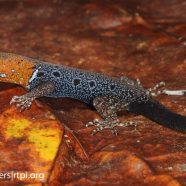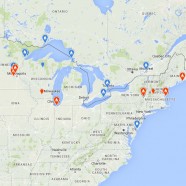Yellow-headed Gecko (Gonatodes albogularis)
Here is the answer to the scale pattern posted yesterday: the Yellow-headed Gecko (Gonatodes albogularis). Twan described it as looking like a bunch of jelly beans or blueberries. The species is very common throughout the Costa Rican lowlands, but few people pay close enough attention to realize how beautiful they are.
Read MoreWild Indigo Duskywing
The Wild Indigo Duskywing (Erynnis baptisiae) butterfly has a subtle iridescence to it if you can get it in the right angle against the sunlight. This is not the most spectacular insect, no – but it looks a great deal more colorful and bold here instead of being a brown, dull triangle in the shade or via a more overhead view.
Read MoreLong-tailed Ducks
These Long-tailed Ducks are showing off some unexpected camouflage on a cloudy day, their black and white plumage matching the patterns of water while on the surface. This species of diving duck certainly spends a long time underwater when it is feeding, and they can even go down to near 200 feet! You never realize how much these birds look like waves until you watch them bobbing up and down on a lake or the sea.
Read MoreGreen-breasted Mango
The Green-breasted Mango (Anthracothorax prevostii) is the most common resident hummingbird species Sean encounters at Finca Pura Vida in Costa Rica. It’s an especially interesting resident because it has a slower molt than most hummingbirds, leading to a mosaic of patterns of juvenile individuals. They often appear to be stuck in between certain plumage ages. This bird is the adult male with gorgeous rich purple and blue gorget on display. Photographed by RTPI Affiliate Sean Graesser for the Meet Your Neighbours global biodiversity project in Costa Rica while on assignment for the...
Read MoreAnother Western Rarity
There are scattered very rare western birds continually being spotted across the Northeast. A gorgeous male Painted Bunting in New York City’s Prospect Park made some big news recently, and yesterday Stefan Martin found a Townsend’s Solitaire in the Cos Cob section of Greenwich, Connecticut. Masschusetts, Vermont, Maine and New York have also had Townsend’s Solitaires recently, as you can see on this eBird occurrence map for the species – orange markers are less than 30 days old while others are from October and early November. Keep your eyes open for all sorts of...
Read More








